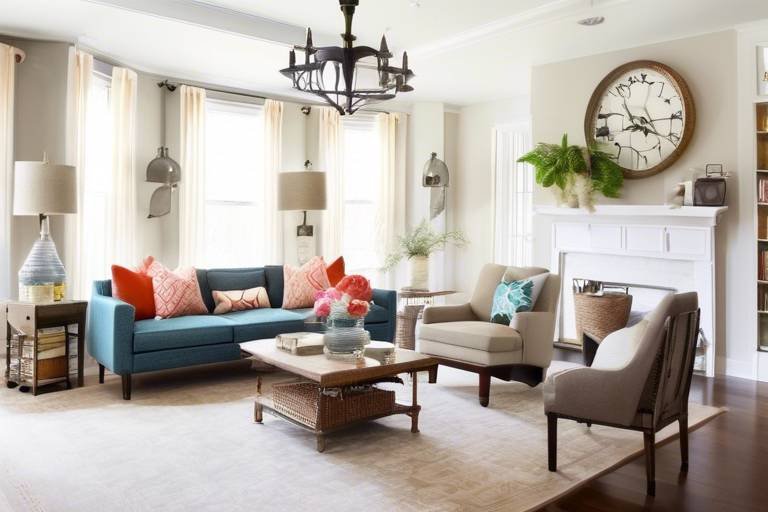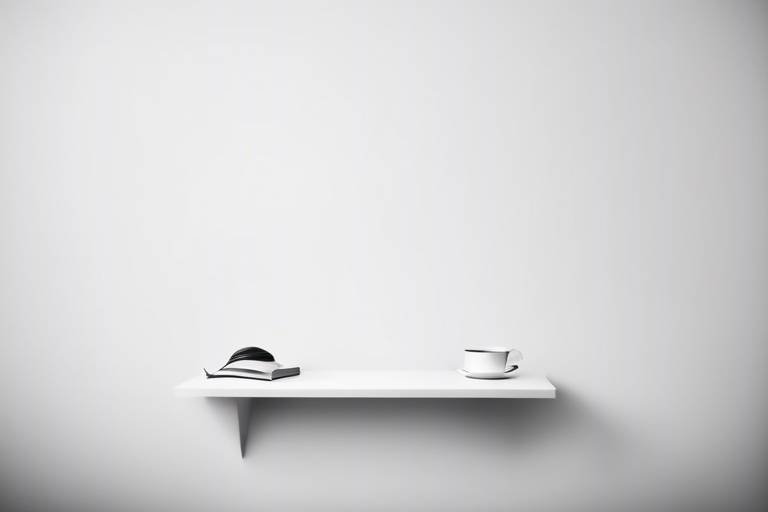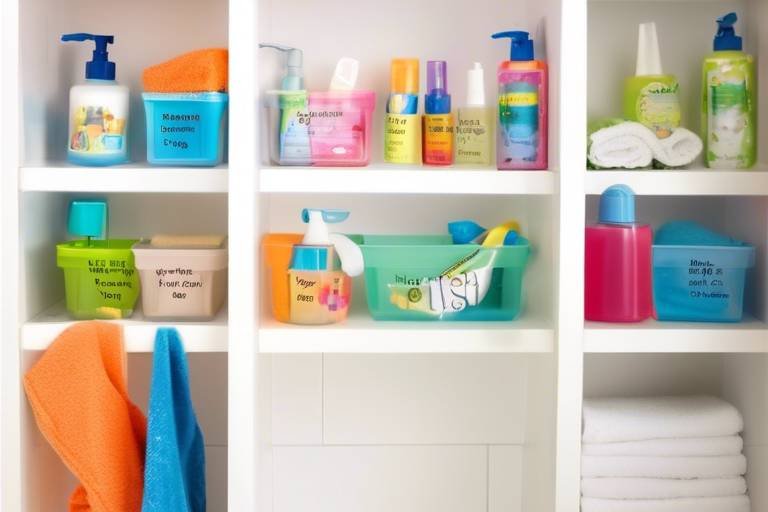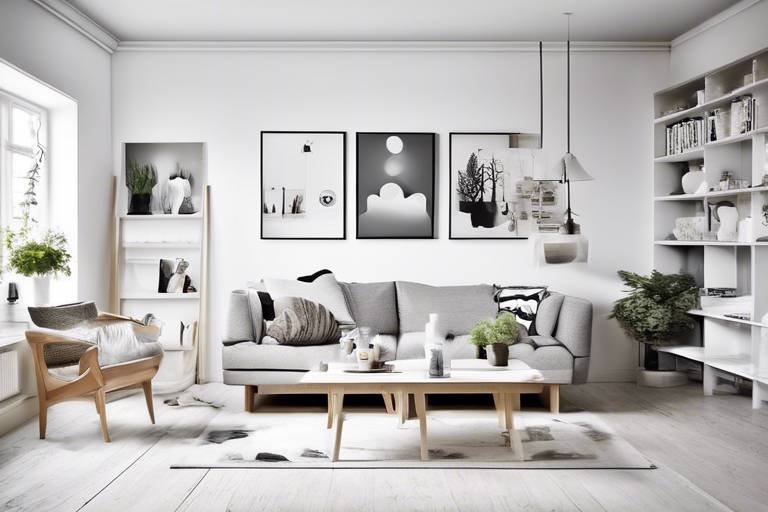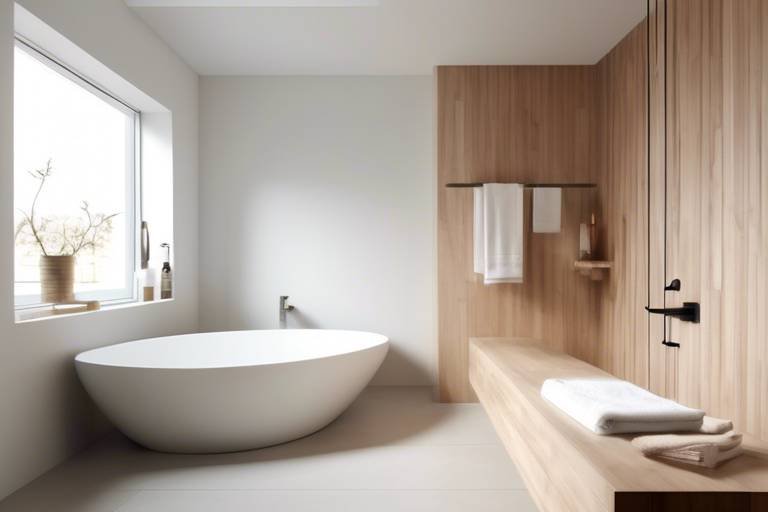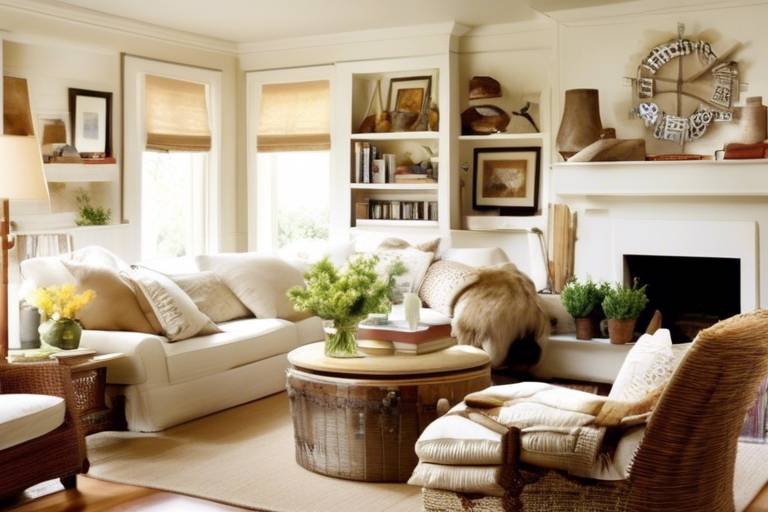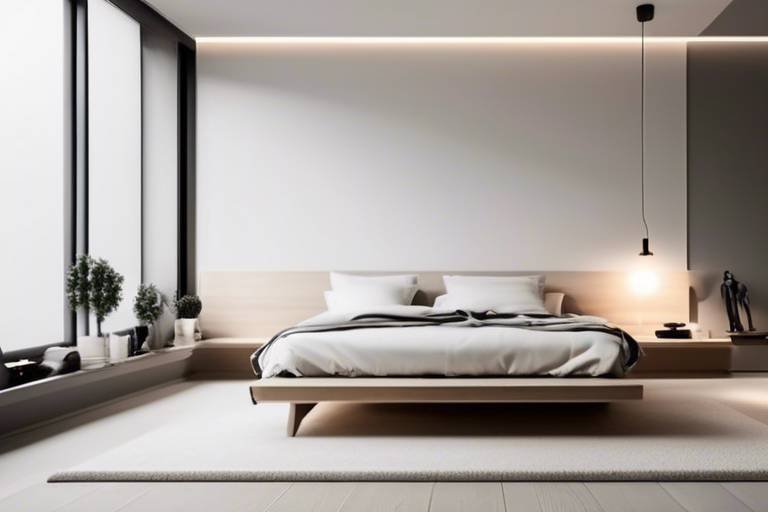Tips for Mixing and Matching Furniture Styles in Your Home
Creating a cohesive look in your home by blending different furniture styles can be challenging. These tips will help you achieve a harmonious and stylish mix of furniture pieces that reflect your personal taste and creativity.
Understanding your style preferences is the first step in mixing and matching furniture styles. Whether you lean towards modern, traditional, rustic, or eclectic designs, knowing your preferences will guide you in selecting pieces that complement each other while showcasing your unique style.
When mixing furniture styles, it's essential to choose a unifying element that ties everything together. This could be a common color palette, material, or shape that creates cohesion and prevents the space from feeling disjointed.
Balance is key when combining different furniture pieces. Mix items of varying sizes and shapes to create visual interest. Pair large statement pieces with smaller accents to maintain harmony and prevent the space from feeling overwhelming.
Experimenting with textures can elevate the overall design of your space. Incorporate a variety of textures such as wood, metal, fabric, and glass to add depth and dimension. Mixing textures adds visual appeal and creates a more dynamic environment.
Consider the scale and placement of each furniture piece to ensure a well-designed space. Pay attention to how items fit in the room and their proportions in relation to one another. Proper placement is crucial for achieving balance and harmony in your home.
Embracing contrast is a powerful way to create a visually stimulating environment. Mixing contrasting styles, such as modern and vintage pieces or light and dark colors, can add intrigue and personality to your home decor. Embrace the unexpected for a unique and dynamic look.
Personalizing your space with accessories is a great way to infuse your personal style. Add throw pillows, rugs, artwork, and lighting to tie together different furniture styles and bring a touch of individuality to your home. Accessories can enhance the overall look and feel of your space.
Trust your instincts and have fun with the process of mixing and matching furniture styles. Follow your intuition, experiment with different combinations, and create a space that truly reflects your personality and creativity. Let your home tell your unique story through its diverse and harmonious furnishings.

Understand Your Style Preferences
Understanding your style preferences is the first step towards creating a harmonious blend of furniture in your home. Your personal taste plays a crucial role in determining the overall look and feel of your living space. Whether you lean towards modern, traditional, rustic, or eclectic styles, recognizing your preferences will help you curate a cohesive and visually appealing environment.
When identifying your preferred furniture styles, consider the elements that resonate with you the most. Do you gravitate towards sleek lines and minimalistic designs, or do you prefer ornate detailing and rich textures? By pinpointing the characteristics that appeal to you, you can begin to envision how different pieces will come together to reflect your unique aesthetic.
Think of your furniture as a reflection of your personality and lifestyle. Are you drawn to cozy and inviting spaces, or do you prefer a more formal and structured atmosphere? Understanding how different styles evoke specific moods and emotions can help you create a home that truly speaks to who you are.
As you explore various furniture styles, don't be afraid to mix and match elements that resonate with you. Combining different styles can add depth and character to your space, showcasing the diverse facets of your design sensibilities. Remember, your home is a canvas for self-expression, so feel free to experiment and create a living environment that feels authentically you.

Choose a Unifying Element
When mixing and matching furniture styles in your home, selecting a unifying element is essential to create a cohesive and harmonious look. This element serves as the thread that ties together different pieces, ensuring that the overall design feels connected and intentional.
One effective way to choose a unifying element is by focusing on a common color palette. By selecting a few key colors that appear throughout the various furniture pieces, you can create a sense of unity and flow in the space. For example, if you have a mix of modern and traditional furniture, choosing a neutral color like beige or gray as a unifying base can help balance the styles and create a cohesive look.
Another approach is to use a specific material as the unifying element. For instance, incorporating elements of wood throughout different furniture pieces can create a sense of warmth and continuity in the room. Whether it's through wooden coffee tables, chairs, or shelves, the consistent use of this material can visually connect the diverse styles present in the space.
Shapes can also serve as a unifying element when mixing furniture styles. By incorporating similar shapes or silhouettes across different pieces, you can establish a sense of harmony and cohesion. For example, if you have a mix of angular and curved furniture, choosing one dominant shape to repeat throughout the room can help create a visually pleasing and unified look.
Ultimately, the key to successfully choosing a unifying element is to ensure that it enhances the overall design without overpowering individual furniture pieces. It should act as a subtle thread that weaves through the space, subtly connecting different styles while allowing each piece to shine in its own right.

Balance Proportions
When it comes to mixing and matching furniture styles in your home, one key aspect to consider is balancing proportions. This involves incorporating furniture of varying sizes and shapes to create a visually appealing and harmonious space. By balancing large statement pieces with smaller items, you can prevent the room from feeling overwhelming and ensure a sense of equilibrium.
Imagine your living room as a carefully orchestrated orchestra, with each piece of furniture playing a unique role. Just like a symphony needs a balance of instruments to create beautiful music, your space requires a mix of furniture sizes to achieve a harmonious composition. A large sofa can be complemented by a set of sleek armchairs, while a bulky coffee table can be balanced by delicate side tables.
Additionally, consider the visual weight of each furniture piece. Heavy, solid pieces can anchor the room, while lighter, more delicate items can provide contrast and interest. It's all about creating a dynamic interplay between different shapes and sizes to keep the eye moving and the space feeling inviting.
One effective way to balance proportions is by creating visual triangles within the room. For example, you can place a tall floor lamp next to a low-slung sofa, with a medium-sized accent chair completing the triangle. This technique helps distribute visual weight evenly throughout the space and creates a sense of cohesion.
Remember, achieving balance in furniture proportions is not about strict symmetry but rather about creating a sense of visual equilibrium. Don't be afraid to experiment with different combinations and arrangements until you find the perfect balance that suits your space and personal style.

Experiment with Textures
When it comes to designing your living space, one of the most effective ways to add depth and visual interest is by experimenting with textures. Incorporating a variety of textures such as wood, metal, fabric, and glass can elevate the overall design of your home, creating a more dynamic and engaging environment.
Imagine a room with sleek leather furniture paired with a plush velvet throw blanket, a rustic wooden coffee table, and a shiny metal lamp. The interplay of these different textures not only adds tactile appeal but also enhances the aesthetic appeal of the space.
Textures can also help in breaking the monotony of a room filled with similar furniture styles. For instance, if you have a predominantly modern furniture collection, introducing a textured rug or a woven basket can introduce a touch of warmth and character to the room.
Furthermore, playing with textures allows you to create a sensory experience within your home. The roughness of a stone accent wall, the smoothness of a glass tabletop, and the softness of a plush rug all contribute to a multi-dimensional space that is both inviting and visually stimulating.
Remember, mixing textures is not just about how things look but also about how they feel. Combining different tactile elements can transform a room from flat and uninspiring to rich and inviting. So, don't be afraid to experiment with textures and let your creativity shine through in your home decor.

Consider Scale and Placement
When mixing and matching furniture styles in your home, it's essential to consider the scale and placement of each piece to achieve a well-balanced look. Scale refers to the size of the furniture in relation to the room and other pieces, while placement involves the arrangement of items to create a harmonious layout.
One way to approach scale is by mixing furniture of different sizes to create visual interest. For example, pairing a large sectional sofa with a sleek coffee table can add dimension to the space. Additionally, balancing proportions by mixing larger statement pieces with smaller accents can prevent the room from feeling overcrowded.
Proper placement of furniture is equally important. Consider the flow of the room and ensure that there is enough space for movement. Avoid placing all the large items on one side of the room, as this can create an unbalanced look. Instead, distribute furniture evenly to create a sense of harmony.
Utilizing tables or shelves can also help in organizing and arranging items effectively. A strategically placed side table can not only serve a functional purpose but also contribute to the overall aesthetic of the room. Similarly, using a bookshelf to display decor items can add personality to the space.
Remember, the key is to find a balance between different furniture sizes and arrange them in a way that maximizes both functionality and visual appeal. By carefully considering scale and placement, you can create a cohesive and well-designed living space that reflects your style and personality.

Embrace Contrast
When it comes to interior design, embracing contrast can take your home decor to a whole new level. Mixing different styles that are seemingly opposite can create a visually stimulating and dynamic environment within your living space. Imagine the sleek lines of a modern sofa paired with the intricate details of a vintage coffee table; the juxtaposition of these contrasting styles can add a layer of intrigue and personality to your home.
Contrast doesn't have to be limited to just furniture styles. You can also play with contrasting colors, textures, and shapes to create a harmonious yet visually exciting space. For example, pairing a bold, dark-colored accent wall with light, neutral furniture can create a striking visual impact while maintaining a sense of balance in the room.
One effective way to embrace contrast is by mixing different design eras. Combining elements from different time periods, such as mid-century modern chairs with a Victorian-style chandelier, can create a unique and eclectic look that showcases your individuality and design sensibility.
Additionally, don't be afraid to mix materials and finishes to add depth and richness to your decor. Incorporating a variety of textures like smooth leather, rough-hewn wood, and shiny metal accents can create a multi-dimensional and visually appealing space that is both inviting and engaging.
Remember, the key to successfully embracing contrast in your home is to strike a balance between the different elements. By carefully curating a mix of styles, colors, textures, and materials, you can create a space that is not only visually stunning but also reflective of your unique personality and design aesthetic.

Personalize with Accessories
When it comes to personalizing your space and adding your unique touch, accessories play a crucial role in tying together different furniture styles. Accessories like throw pillows, rugs, artwork, and lighting can elevate the overall look of your home and reflect your personality.
Consider using throw pillows with varying textures and patterns to add depth to your furniture pieces. A mix of different textures such as velvet, silk, or faux fur can create visual interest and make your seating area more inviting.
Rugs are another great way to personalize your space. Choose a rug that complements the style of your furniture while adding a pop of color or pattern to the room. A well-placed rug can define different areas within a space and bring cohesion to the overall design.
Artwork is a fantastic way to showcase your personality and add character to your home. Whether you prefer abstract paintings, photography, or sculptures, art can be a conversation starter and a focal point in any room. Mix and match different art pieces to create a gallery wall or display them individually to make a statement.
Lighting is essential for setting the mood and ambiance of a room. Consider incorporating a mix of overhead lighting, floor lamps, table lamps, and wall sconces to illuminate different areas and create a warm and inviting atmosphere. Choose lighting fixtures that complement your furniture styles and add a touch of elegance to the space.
Remember, accessories are the finishing touches that bring a space to life and make it feel like home. Personalize your space with accessories that speak to your taste and style, and don't be afraid to mix and match different elements to create a cohesive and personalized look.

Trust Your Instincts
Creating a cohesive look in your home by blending different furniture styles can be challenging. These tips will help you achieve a harmonious and stylish mix of furniture pieces that reflect your personal taste and creativity.
When it comes to mixing and matching furniture styles, one of the most important things you can do is trust your instincts. Your intuition is a powerful tool in creating a space that feels uniquely yours. Don't be afraid to follow your gut and experiment with different combinations. Sometimes the most unexpected pairings can result in the most striking and personal designs.
Think of your instincts as your interior design compass, guiding you towards choices that resonate with you on a deeper level. Whether it's a bold color choice, an unconventional furniture pairing, or a unique accessory, embracing your instincts can lead to a space that truly reflects your personality and creativity.
Remember, design rules are meant to be broken, and your home should be a reflection of your individuality. Trusting your instincts means allowing yourself the freedom to explore and express your style in a way that feels authentic to you. So go ahead, trust your instincts, have fun with the process, and create a space that is uniquely yours.
Frequently Asked Questions
- How can I mix modern and traditional furniture styles?
To mix modern and traditional furniture styles, consider using a unifying element such as color or material to tie the pieces together. You can also balance proportions by pairing larger modern pieces with smaller traditional ones to create visual interest.
- What are some tips for incorporating eclectic furniture styles?
When incorporating eclectic furniture styles, focus on balancing scale and placement to ensure a cohesive look. Experiment with textures and embrace contrast by mixing different styles to create a dynamic and visually stimulating environment.
- How important is personalization with accessories in mixing furniture styles?
Personalizing with accessories is crucial in tying together different furniture styles and adding a touch of individuality to your home. Accessories like throw pillows, rugs, and artwork can enhance the overall design and reflect your personal style.

